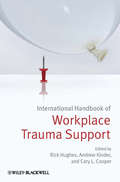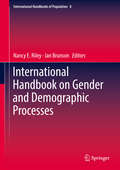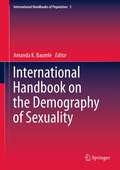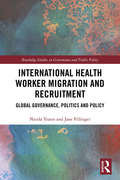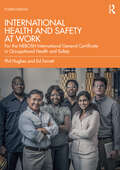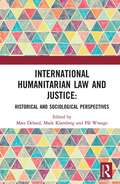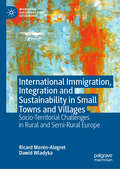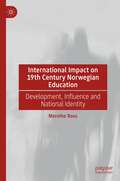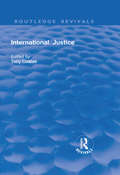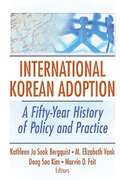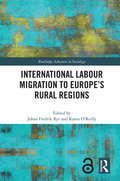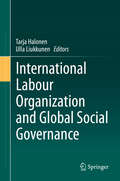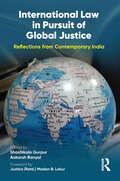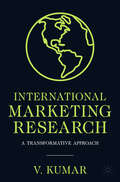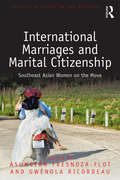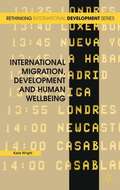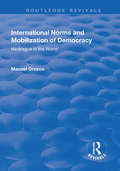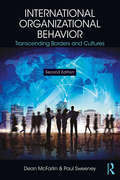- Table View
- List View
International Handbook of Workplace Trauma Support
by Cary L. Cooper Rick Hughes Andrew KinderThe International Handbook of Workplace Trauma Support provides a comprehensive overview of contemporary standards and best practices in trauma support that draws from the latest research findings and experience of international experts in the field.Reviews the major contemporary post-trauma intervention models in both theory and practiceIncludes Trauma Risk Management (TRiM), Support Post Trauma (SPoT), Eye-Movement Desensitization and Reprocessing (EMDR), Mindfulness and Psychological First Aid (PFA)Incorporates multi-cultural perspectives by reporting on the pervasive violence in South Africa, constant threats in Israel and emerging developments in ChinaIncludes social, psychosocial, psychological, and organizational dimensions to offer a detailed mapping of trauma supportProvides latest thinking for supporting those in the military context
International Handbook on Gender and Demographic Processes (International Handbooks Of Population Ser. #8)
by Jan Brunson Nancy E. RileyThis handbook presents a comprehensive and up-to-date overview of gender in demography, addressing the many different influences of gender that arise from or influence demographic processes. It collects in one volume the key issues and perspectives in this area, whereby demography is broadly defined. The purpose in casting a wide net is to cover the range of work being done within demography, but at the same time to open up our perspectives to neighboring fields to encourage better conversations around these issues.The chapters in this handbook carefully document definition and measurement issues, and take up parts of the demographic picture and focus on how gender plays a role in outcomes. In other cases, gender often plays a cross-cutting role in social processes; rather than having a single or easily distinguishable role, it often combines with other social institutions and even other statuses and inequalities to affect outcomes. Thus, a key factor in this volume is how gender interacts with race/ethnicity, class, nationality, and sexuality in any demographic setting.While each section contains chapters that are broad overviews of the current state of knowledge and behavior, the handbook also includes chapters that focus on specific cultures or events in order to examine how gender operates in a particular circumstance.
International Handbook on the Demography of Marriage and the Family (International Handbooks of Population #7)
by Karista K. Hughes Elizabeth Harmon ThreattThis handbook provides a global perspective on contemporary demographic theories and studies of marriage and the family. Inside, readers will find a comprehensive analysis that enables demographic comparison between and across international borders. Coverage is centered around four main sections that present a history of marriage and the family, detail relevant data and measurement concerns, examine global marriage practices, analyze interactions of such demographic characteristics as age, sex, and race with marriage and the family, and consider public policy, contemporary trends, and future directions. In addition, the book includes research on current social issues such as alternative family structures, cohabitation, divorce, boomerang children, and adoption. The family is universal but extremely varied in form and function. This handbook provides students, researchers, and policymakers with an all-inclusive, international demographic analysis that fully investigates the diverse nature of the modern family.
International Handbook on the Demography of Sexuality
by Amanda K. BaumleThe International Handbook on the Demography of Sexuality is the first book to specifically address the study of sexuality from a demographic perspective. Demographic research has largely paid little attention to sexuality as a whole, or sexual orientation in particular, other than in studies examining the "consequences" of sex - sexually transmitted infections or fertility. Instead, the content of this handbook explores population sexuality in order to describe the prevalence of sexual behaviors, desires, and identities, as well as their connections with other demographic outcomes. The focus is on analyzing sexuality as a demographic topic in its own right, rather than solely as a variable in studies of sexually transmitted infection or other health-related topics. In this book, both researchers with traditional demographic backgrounds, as well as those with training in other disciplines, provide an overview of the state of current research on population sexuality. These chapters provide a foundation for the development of research in the burgeoning field of the demography of sexuality.
International Health Worker Migration and Recruitment: Global Governance, Politics and Policy (Routledge Studies in Governance and Public Policy)
by Nicola Yeates Jane PillingerThis book is the first comprehensive study of international health worker-migration and -recruitment from the perspective of global governance, policy and politics. Covering 70 years of history of the development of this global policy field, this book presents new and previously unpublished data, based on primary research, to reveal for the first time that international health worker-migration-and -recruitment have been major concerns of global policy-making going back to the foundations of post-war international cooperation. The authors analyse the policies and programmes of a wide range of international organisations, from WHO, ILO and UNESCO to the IOM, World Bank and OECD, and feature extended analysis of bilateral agreements to manage health worker migration and recruitment, critiquing the claim that they work in the interests of all countries. Yeates’ and Pillinger’s ground-breaking analysis of global governance presents an assiduously researched study showing how the interplay and intersections of several global institutional regimes – spanning labour, migration, health, social protection, trade and business, equality and human rights – shape global policy responses to this major health care issue that affects all countries worldwide. It discusses the growing challenges to public health as a result of the globalisation of health labour markets, and highlights how global and national policy can realise the health and health-related Sustainable Development Goals for all by 2030. This research monograph will be of key interest to students and scholars of Global Governance, Global Public Policy, Global Health, Global Politics, Migration Studies, Health and Social Care, Social Policy and Development Studies. Policy makers and campaign activists, nationally and globally, will appreciate the practical relevance and applications of the research findings.
International Health and Safety at Work Revision Guide: for the NEBOSH International General Certificate in Occupational Health and Safety
by Ed FerrettThis companion to the renowned International Health and Safety at Work textbook by Hughes and Ferrett is an essential revision aid for students preparing for their written assessments on the NEBOSH International General Certificate in Occupational Health and Safety. Fully updated to the 2019 specification, the revision guide provides complete coverage of the syllabus in bite-sized chunks, helping readers to learn and memorise the most important topics. Throughout the book, the guide links back to the International Health and Safety at Work textbook, helping students to consolidate their learning. Small and portable making it ideal for use anywhere – at home, in the classroom or on the move – the revision guide suggests useful tips on study and examination technique. It includes practice questions and answers based on NEBOSH exam questions, providing everything you need for productive revision in one handy reference. Now in its third edition, the International Health and Safety Revision Guide, written by the renowned health and safety author and former NEBOSH Vice Chairman Ed Ferrett, is an invaluable tool for students as they prepare for their NEBOSH exam and for their subsequent health and safety work.
International Health and Safety at Work: for the NEBOSH International General Certificate in Occupational Health and Safety
by Ed Ferrett Phil Hughes MBEInternational Health and Safety at Work has been specially written in simple English for the thousands of students who complete the NEBOSH International General Certificate in Health and Safety each year. Fully revised in alignment with the 2019 syllabus, this fourth edition provides students with all they need to tackle the course with confidence. Clear, easily accessible information is presented in full colour, with discussion of essential principles such as ILO and OSH conventions as well as legal frameworks from a range of countries. The book features practice questions and answers to test knowledge and increase understanding. International Health and Safety at Work remains the most effective tool for those working to fit international health and safety standards to local needs and practice.
International Housing Market Experience and Implications for China (Routledge Studies in International Real Estate)
by Bertrand Renaud Rebecca L. Chiu Zhi LiuRecent rapid housing market expansion in China is presenting new challenges for policy makers, planners, business people, and citizens. Now that housing in middle-income China is driven by consumer choices and is no longer dominated by state policy decisions, housing policy issues in Chinese cities are becoming increasingly similar to those encountered in other global housing markets. With soaring prices and imbalances in housing supply favoring high income groups and housing demand driven by rising inequality in household incomes, many middle and lower-income households face worsening choices in terms of the quality and location of their housing as well as greater financial difficulties, which together can have negative implications for standards of public health. This book examines the impact of these changes on the general population, as well as on aspiring homeowners and developers. The contributors look at the effect on the widening of wealth gaps, slower economic growth, and threats to political and social stability. Though focusing on China, the editors also present discussions of specific policy design challenges encountered in Australia, Japan, Korea, the Netherlands, the Nordic countries, Singapore, Taiwan, the UK, and the US. This book would be of interest to housing policy makers, as well as academics who are studying the social and political effects of the Chinese housing market.
International Humanitarian Law and Justice: Historical and Sociological Perspectives
by Mats Deland Mark Klamberg Pål WrangeIn the last decade, there has been a turn to history in international humanitarian law and its accompanying fields. To examine this historization and to expand the current scope of scholarship, this book brings together scholars from various fields, including law, history, sociology, and international relations. Human rights law, international criminal law, and the law on the use of force are all explored across the text’s four main themes: historiographies of selected fields of international law; evolution of specific international humanitarian law rules in the context of legal gaps and fault lines; emotions as a factor in international law; and how actors can influence history. This work will enhance and broaden readers’ knowledge of the field and serve as an excellent starting point for further research.
International Immigration, Integration and Sustainability in Small Towns and Villages: Socio-Territorial Challenges in Rural and Semi-Rural Europe (Migration, Diasporas and Citizenship)
by Ricard Morén-Alegret Dawid WladykaThis book brings small places to the main stage in an exploration of the nature of immigration in rural areas and small towns in Europe. Extending recent efforts to study migration at a sub-national scale, the authors focus their analysis on non-metropolitan areas to consider how globalisation and modernisation processes are experienced at a local level. Morén-Alegret and Wladyka weave themes of livelihood, social participation, justice and equity into human and planetary sustainability debates, drawing on quantitative population data as well as qualitative information on challenges for rural and small town sustainability in four different European countries (Portugal, France, Spain and England).Highlighting the interlinked relationship between rural sustainability, migration and ethnic diversity, this research is a valuable resource for policy-makers and academics alike, with far-reaching implications across geography, sociology, political science, anthropology and environmental sciences.
International Impact on 19th Century Norwegian Education: Development, Influence and National Identity
by Merethe RoosThis book examines Norwegian education throughout the course of the 19th century, and discusses its development in light of broader transnational impulses. The nineteenth century is regarded as a period of increasing national consciousness in Norway, pointing forward to the political independency that the country was granted in 1905. Education played an important role in this process of nationalisation: the author posits that transnational – for the most part Scandinavian – impulses were more decisive for the development of Norwegian education than has been acknowledged in previous research. Drawing on the work of educator and school bureaucrat Hartvig Nissen, who is recognised as the most important educational strategist in 19th century Norway, this book will be of interest to scholars of the history of education and Norwegian education more generally.
International Justice: Principles and Issues (Routledge Revivals Ser.)
by Tony CoatesThis title was first published in 2000: Part of the academic response to the phenomenon of globalization, this text explores the legal and philosophical implications with particular reference to the problem of international justice. Among the issues examined in the book are those dealing with matters of principle and with the philosophical grounding of international justice: is a moral universalism possible? Are the claims of moral universalism reconcilable with those of moral particularism? What kind of moral universalism does international justice entail? How does the concept of right bear upon international justice? Is justice, both distributive and formal, applicable to international relations? Other issues discussed are of a more specific nature: is there a right to development? What is the role of justice in the resolution of conflict? is humanitarian intervention justified? What are the ethical implications of global warming and acid rain?
International Korean Adoption: A Fifty-Year History of Policy and Practice
by Kathleen Ja Sook Bergquist M. Elizabeth Vonk Dong Soo Kim Marvin D. FeitDiscover the roots of international transracial adoption International Korean Adoption: A Fifty-Year History of Policy and Practice explores the long history of international transracial adoption. Scholars present the expert multidisciplinary perspectives and up-to-date research on this most significant and longstanding form of international child welfare practice. Viewpoints and research are discussed from the academic disciplines of psychology, ethnic studies, sociology, social work, and anthropology. The chapters examine sociohistorical background, the forming of new families, reflections on Korean adoption, birth country perspectives, global perspectives, implications for practice, and archival, historical, and current resources on Korean adoption. International Korean Adoption: A Fifty-Year History of Policy and Practice provides fresh insight into the origins, development, and institutionalization of Korean adoption. Through original research and personal accounts, this revealing text explores how Korean adoptees and their families fit into their family roles--and offers clear perspectives on adoption as child welfare practice. Global implications and politics, as well as the very personal experiences are examined in detail. This source is a one-of-a-kind look into the full spectrum of information pertaining to Korean adoption. Topics in International Korean Adoption: A Fifty-Year History of Policy and Practice include: adoption from the Korean perspective historical origins of Korean adoption in the United States adjustments of young adult adoptees marketing to choosy adopters ethnic identity perspectives on the importance of race and culture in parenting birth mothers' perspectives sociological approach to race and identity representations of adoptees in Korean popular culture adoption in Australia and the Netherlands much, much more International Korean Adoption: A Fifty-Year History of Policy and Practice is illuminating reading for adoptees, adoptive parents, practitioners, educators, students, and any child welfare professional.
International Labour Migration in the Middle East and Asia: Issues of Inclusion and Exclusion (Asia in Transition #8)
by Kwen Fee Lian Naomi Hosoda Masako IshiiThe discourse on migration outcomes in the West has largely been dominated by issues of integration, but it is more relevant to view immigration in non-Western societies in relation to practices of exclusion and inclusion. Exclusion refers to a situation in which individuals and groups are usually denied access to the goods, services, activities and resources associated with citizenship. However, this approach has been criticised in relation to gender issues, which are very relevant to the situation of migrants. The authors in this volume address this criticism. Furthermore, when framed within a North–South discourse, it may be potentially ethnocentric to assume that the experience of exclusion is cross-culturally uniform. Indeed, work on migration issues has invariably been conducted within such a discourse. The contributors go beyond this binary discourse of ‘exclusion versus inclusion’ which has dominated migration research. They examine the situation of migrants in the Middle East and Asia as one that encompasses both exclusion and inclusion, addressing related concepts of empowerment, ethnocracy, the feminisation of migration and gendered geographies of power, liberal constraint and multiculturalism, individual agency, migrant-friendly discourses, spaces of emancipation and spaces of insecurity. The book highlights current research in the Arab Gulf states, and examines multiculturalism in Asia more broadly. It will be of particular interest to students and researchers in international labour migration studies in the Middle East and Asia.
International Labour Migration to Europe’s Rural Regions (Routledge Advances in Sociology)
by Johan Fredrik RyeEmerging in the throes of a global pandemic that threatens Europe’s economies and food security, International Labour Migration to Europe’s Rural Regions combines a diverse range of empirically rich, in-depth case studies, analysis of their rural context specificities, and insights from labour market and migration theories, to critically examine the conditions and implications of rural labour migration. Despite its growing political, economic and social importance, our understanding of international labour migration to Europe’s rural regions remains limited. This edited volume provides intricate descriptions of lived experience, critical theoretical analyses, analytical synthesis, and policy recommendations for this novel and developing phenomenon that has the potential to transform the lives of international migrants and local communities. The book’s 25 authors represent a wide range of social science disciplines, with coverage of a vast range of Europe’s rural regions, and diverse types of rural labour in areas such as horticulture, shepherding, wild berry picking and fish processing. The volume will be of interest to policy makers at local, regional, national and European levels, and scholars and students in a broad range of areas, including migration, labour markets, and rural studies.
International Labour Organization and Global Social Governance
by Ulla Liukkunen Tarja HalonenThis open access book explores the role of the ILO (International Labour Organization) in building global social governance from multiple and mutually complementary perspectives. It explores the impact of this UN´s oldest agency, founded in 1919, on the transforming world of work in a global setting, providing insights into the unique history and functions of the ILO as an organization and the evolution of workers’ rights through international labour standards stemming from its regulatory mechanism.The book examines the persistent dilemma of balancing the benefits of globalization with the protection of workers. It critically assesses the challenges that emerge when international labour standards are implemented and enforced in highly diverse regulatory frameworks in international, regional, national and local contexts. The book also identifies feasible ways to achieve more inclusive labour protection, putting into perspective the tension between the economic and the social in the ILO’s second century of operation. It includes reflections on the work of the ILO World Commission on the Social Dimension of Globalisation by Tarja Halonen, who as President of Finland co-chaired the Commission with Benjamin William Mkapa, President of Tanzania.Written by distinguished experts and scholars in the fields of international labour law and international law, the book provides an insightful and in-depth analysis of the role of the ILO as an international organization devoted to decent work and social justice. It also sheds light on tripartism and its particular role in the work of the ILO, examining the challenges that a profoundly changing working life presents in terms of labour protection and social justice, and examining the transnational dimension of labour law. Lastly, the book includes a postscript by Nobel economics laureate Professor Joseph E. Stiglitz.
International Law in Pursuit of Global Justice: Reflections from Contemporary India
by Shashikala Gurpur Aakarsh BanyalThis book discusses the core concepts of international law with a focus on India’s position concerning contemporary developments in the field.The project of international law—both in its origin and evolution—has been predominantly anchored in Global North realities. Over the years, however, narratives from ‘other’ parts of the world (the Global South) have emerged to confront the traditional construction of the international legal order. The Indian narrative(s) in this regard, given the state’s expanding influence within the Global South and beyond, therefore, warrants consideration. This book responds in three ways: captures India’s contributions to the development of international law in areas including human rights, humanitarian law, international trade and investment, global commons, health, and dispute settlement; evaluates the influence of international law on India and its positioning in the global world order; and presents a way forward by mapping India’s pursuit of global justice.The book will be of interest to scholars and students working in the fields of International Law, South Asian Studies, International Relations, Human Rights, and related research areas.
International Leasing: Strategy and Decision (Routledge Revivals)
by Simon S. GaoFirst published in 1999, This book aims to study international leasing, in which it mainly looks at leasing on an international scale; considering how we define leasing itself and in the context of the international financial world.
International Marketing Research: A Transformative Approach
by V. KumarThis book provides a practical, detailed, and well-documented guide that takes students and market researchers through all phases of developing and conducting global marketing research. This book not only accounts for the recent developments in the scope and extent of global marketing research, but also examines advances in both quantitative and qualitative research techniques, and the impact of the Internet on research in the global environment.It includes coverage of all phases involved in designing and executing global marketing research -- from analyzing the nature and scope of the research to the preliminary stages, gathering data, designing the questionnaires, sampling, and presenting the data. Numerous country-specific examples and case studies will add to the understanding of the concepts laid out in the book. This edition features updates related to leveraging the power of AI, Internet of Things, machine learning, blockchain, robotics, the metaverse, and otheremerging technologies that are impacting the way in which marketing research is performed. With an instructor’s manual as well as PPT slides covering major topics within the chapters, in addition to numerous cases, this text provides the most current and relevant information about the global marketing research industry and outlines the necessary techniques that can guide researchers in their work.
International Marriages and Marital Citizenship: Southeast Asian Women on the Move (Studies in Migration and Diaspora)
by Asuncion Fresnoza-Flot Gwénola RicordeauWhile marriage has lost its popularity in many developed countries and is no longer an obligatory path to family formation, it has gained momentum among binational couples as states reinforce their control over human migration. Focusing on the case of Southeast Asian women who have been epitomized on the global marriage market as ‘ideal’ brides and wives, this volume examines these women’s experiences of international marriage, migration, and states' governmentality. Drawing from ethnographic research and policy analyses, this book sheds light on the way many countries in Southeast Asia and beyond have redefined marriage and national belonging through their regime of ‘marital citizenship’ (that is, a legal status granted by a state to a migrant by virtue of his/her marriage to one of its citizens). These regimes influence the familial and social incorporation of Southeast Asian migrant women, notably their access to socio-political and civic rights in their receiving countries. The case studies analysed in this volume highlight these women’s subjectivity and agency as they embrace, resist, and navigate the intricate legal and socio-cultural frameworks of citizenship. As such, it will appeal to sociologists, geographers, socio-legal scholars, and anthropologists with interests in migration, family formation, intimate relations, and gender.
International Migration and Ethnic Relations: Critical Perspectives (Routledge Advances in Sociology)
by Magnus Dahlstedt Anders NeergaardEach day, in so many aspects of daily life, we are reminded of the significance of migration and ethnicity. This book is a critical contribution to the understanding of the phenomena of migration and ethnicity, from a Swedish vantage point looking outwards towards a European context. It presents current academic debates and gives a theoretical overview of nine key concepts in the field of ethnic and migrations studies, but it also exemplifies how these concepts could be used in analysing specific empirical cases. It explores the following concepts: ethnicity; migration; diaspora; citizenship; intersectionality; racism; right wing populism; social exclusion; and informalisation. The book is interdisciplinary, embracing areas such as labour studies, economic history, ethnicity, business administration, gender studies, literature studies, economics, educational science, social anthropology, social work, sociology and political science.
International Migration in Cuba: Accumulation, Imperial Designs, and Transnational Social Fields
by Alejandro Portes Margarita Cervantes-RodríguezSince the arrival of the Spanish conquerors at the beginning of the colonial period, Cuba has been hugely influenced by international migration. Between 1791 and 1810, for instance, many French people migrated to Cuba in the wake of the purchase of Louisiana by the United States and turmoil in Saint-Domingue. Between 1847 and 1874, Cuba was the main recipient of Chinese indentured laborers in Latin America. During the nineteenth century as a whole, more Spanish people migrated to Cuba than anywhere else in the Americas, and hundreds of thousands of slaves were taken to the island. The first decades of the twentieth century saw large numbers of immigrants and temporary workers from various societies arrive in Cuba. And since the revolution of 1959, a continuous outflow of Cubans toward many countries has taken place—with lasting consequences.In this book, the most comprehensive study of international migration in Cuba ever undertaken, Margarita Cervantes-Rodríguez aims to elucidate the forces that have shaped international migration and the involvement of the migrants in transnational social fields since the beginning of the colonial period. Drawing on Fernand Braudel’s concept of longue durée, transnational studies, perspectives on power, and other theoretical frameworks, the author places her analysis in a much wider historical and theoretical perspective than has previously been applied to the study of international migration in Cuba, making this a work of substantial interest to social scientists as well as historians.
International Migration, Development and Human Wellbeing
by Katie WrightKatie Wright explores how human wellbeing is constructed and how it 'travels' across spatial boundaries. She draws on empirical research, undertaken with Peruvian migrants based in London and Madrid and their Peru-based relatives and close friends to explore how human wellbeing is constructed and how it 'travels' transnationally.
International Norms and Mobilization for Democracy: Nicaragua in the World (Routledge Revivals)
by Manuel OrozcoThis title was first published in 2002: This volume demonstrates that international action for democracy does not solely rest on American democracy promotion strategies, but that it actually depends on a variety of global actors and interactions. It is suitable for policy experts, non-governmental organizations, international aid agencies and courses on international relations theory, comparative politics, and Latin American politics. The book: introduces a theoretical framework about the effect of international norms on democracy promotion; connects the role of international institutions and norms with advocacy movements in shaping the mobilization to promote democracy; analyses the relationship between the international dimension of democracy promotion and democratization; explains the effect of international democracy promotion in the political transition of Nicaragua from 1979 to 2001; and brings into analysis the various modalities of democracy promotion and their effects.
International Organizational Behavior: Transcending Borders and Cultures
by Dean McFarlin Paul SweeneyThis book focuses on understanding and managing organizational behavior in an international context, considering the conceptual framework of culture and offering practical advice for navigating cultures in the workplace. Readers will gain new tools to interpret behavior, helping them to manage international challenges effectively. The authors outline the critical management and adaptation skills necessary to develop within a globalized organization, teaching the reader how to recruit, coordinate, and evaluate an international team. Updated "Culture Clash" and "Global Innovations" boxes provide important insights into identifying a core set of values to "customize" management techniques across cultures, focusing particularly on growing countries like India and China. The new edition features a more streamlined chapter structure, updated discussion questions, and new end-of-chapter cases with self-scoring quizzes for further development. International Organizational Behavior will prove a valuable resource for any student of organizational behavior, international management, and international business. A companion website provides additional support for instructors, featuring an instructor’s manual, test bank, and PowerPoint slides.
